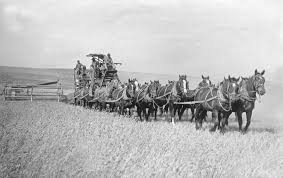FARMING WITH HORSES
CATEGORY: GRASS VALLEY
PHOTO: HARVESTING WITH HORSES
 When we first moved to Grass Valley, Grandfather and Uncle Wallace didn’t have a tractor. All the farming was done with horses. They had a team of draft horses named Blacky and Bess. The first use of those horses in the yearly cycle of growing wheat, starting in the fall, was to pull the plow, which consisted of several curved and sharpened plow blades mounted in a metal frame. After that, they were hitched to the disk. It had round, concave blades that looked like the metal symbols on a tambourine, only a hundred times bigger. The purpose of a disk was to break up the soil into smaller pieces. After that, a harrow was used to till the soil even finer, and then wheat was poured into the long trough of the seeder from which the grains fell into a dozen or more cone shaped nozzles and from them into the ground where they were covered with earth by another blade. For all this Blacky and Bessie plodded patiently round and round each field, time after time, day after day.
When we first moved to Grass Valley, Grandfather and Uncle Wallace didn’t have a tractor. All the farming was done with horses. They had a team of draft horses named Blacky and Bess. The first use of those horses in the yearly cycle of growing wheat, starting in the fall, was to pull the plow, which consisted of several curved and sharpened plow blades mounted in a metal frame. After that, they were hitched to the disk. It had round, concave blades that looked like the metal symbols on a tambourine, only a hundred times bigger. The purpose of a disk was to break up the soil into smaller pieces. After that, a harrow was used to till the soil even finer, and then wheat was poured into the long trough of the seeder from which the grains fell into a dozen or more cone shaped nozzles and from them into the ground where they were covered with earth by another blade. For all this Blacky and Bessie plodded patiently round and round each field, time after time, day after day.
Around the edge of each field was a “right of way” which was planted with “hay seed” or the seed that would produce the best hay. This hay swath would be cut first, before the grain was harvested, so that when the combine came into the field with its cutter bar off to one side, the tractor and the main body of the combine would have a place to move without trampling any of the grain to be harvested. Haying involved more work for the horses: first circling the field with the sickle bar that cut the hay, followed by the hay rake with its large curved tines, bigger than barrel hoops, that raked the hay into windrows. After that the horses were allowed to rest and the windrows were pitched into shocks by hand, a shock being the small pile of hay from one windrow that could easily be pitched into the wagon. Then the horses would be hitched to the header bed, a wagon that had a high side and a low side. The hay from the shocks was pitched over the low side, piled up against the high side until the wagon was full, and then taken to the barns.
In those years the wheat was harvested by traveling combines that came from someplace out of the unknown world along with their own crews and ten-horse teams. These big combines had chutes that held four or five sacks of wheat. When the sack sewer pulled the cord the sacks would fall down onto the stubble of the field. That was when the fun started!
Grandfather would hitch Blacky and Bess to the flat-bed wagon, similar to a buck board, and go out into the field and load the wagon with the sacks of wheat. We would go with him and drive the horses ahead from one row of sacks to the next. When the wagon was loaded Grandfather would drive the horses and we would ride on top the sacks back through the ranch, out onto the highway, all the way into town and through town to the wheat elevator. Sometimes we picked up other kids along the way who would run and jump up beside us. At that time in our little town, there was no one to be afraid of. The whole town was baby sitter for all the children, so most kids, mostly boys, were free to roam all over town and might turn up anywhere.
Sometime in the late ’30’s Uncle Wallace sold Blackie and Bess and got a brand new John Deer tractor. It was the end of an era. Now gasoline was consumed instead of hay, and a large gasoline tank was installed near the wagon shed where the tractor was parked beside the wagons. It didn’t smell nearly as good as horses and hay.
